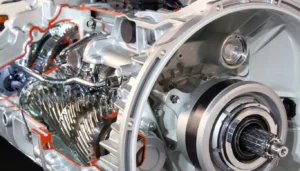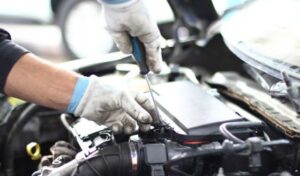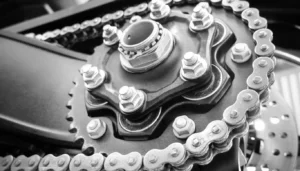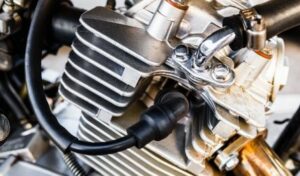Have you been frustrated by your motorbike idling at a higher RPM than usual? Imagine your bike revving at a stoplight instead of purring. It’s annoying and may indicate a problem. This article will explore high idle issues and offer troubleshooting tips to get your motorcycle idling smoothly again.
Motorcycle idling is essential. First, it smooths the acceleration from stationary to acceleration for a controlled start. Second, idling at the right RPM maintains engine temperature and lubrication, reducing wear. Finally, a steady idle speed saves gas money. Understanding and fixing high idle issues quickly will help your motorcycle last longer.
Why Is My Motorcycle Idling High?
The following is a list of all of the possible reasons why a motorcycle has a high idling speed.
1. Improperly Adjusted Throttle Stop
The throttle stop, also known as an idle speed screw, is a component that sets the baseline throttle position when the throttle grip is completely released. The throttle stop is typically located on the carburetor for carbureted engines or on the throttle body for fuel-injected engines.
Symptoms
If your motorcycle’s throttle stop is improperly adjusted, one of the most prominent signs will be a high idle speed. Even at idle, the engine’s RPM is higher than normal.
When you let off the throttle, the motorcycle’s RPM may not drop as expected or take longer to return to idle. These symptoms are typically consistent, meaning they occur every time the engine is running and not just under certain conditions or at specific times.
Fixes
Fixing an improperly adjusted throttle stop usually involves adjusting the throttle stop screw itself. Here’s a simple step-by-step guide on how to do this:
- Start your motorcycle to warm up.
- Locate the throttle stop screw. It’s typically found on the side of the carburetor or throttle body, often towards the top.
- Using a suitable screwdriver, gently turn the screw. In many cases, you’ll need to turn it counterclockwise to reduce the idle speed, but this can vary depending on the specific motorcycle.
- Turn the screw slowly, checking the RPM after each small adjustment. The goal is to lower the idle speed without causing the engine to stall or run roughly.
- Once you’ve adjusted the screw and are happy with the idle speed, take the motorcycle for a short test ride to ensure it behaves normally under different conditions.
Adjusting the throttle stop can be done at home, but if you’re unsure or the problem persists, consult a mechanic. If you’re unsure, consult a professional because a high idle speed may indicate a more serious issue.
2. Air/Fuel Mixture
The air/fuel mixture is the ratio of air to fuel in your motorcycle’s engine. This mixture is crucial to the engine’s performance. A “lean” engine receives too much air or fuel. Conversely, if there’s too much fuel or not enough air, the engine is said to be running “rich.”
Symptoms
If your motorcycle is idling high due to an incorrect air/fuel mixture, you might experience the following symptoms:
- High idling, even when the engine is warmed up.
- The engine might stutter or hesitate, especially when you’re accelerating.
- You may notice a lack of power or throttle response.
- Backfiring or popping sounds from the exhaust.
- Unusual exhaust smell, often gasoline-like if running rich or a hot, metallic smell if running lean.
Fixes
Adjusting the air/fuel mixture can be done, although the steps to take depend on whether your motorcycle has a carburetor or fuel injectors:
Carburetor
- Warm up the engine to its normal operating temperature.
- Locate the air/fuel mixture screw on the carburetor. This is usually a carburetor screw on the side.
- To adjust the mixture, turn the screw very slowly while observing the engine’s behavior. Turning the screw clockwise leans the mixture, while anticlockwise richens it.
- Make small adjustments until the engine runs smoothly at idle and doesn’t exhibit the symptoms mentioned above.
Fuel Injection
The engine control unit (ECU) controls the air/fuel mixture for fuel-injected motorcycles based on sensor input. Therefore, adjustment is typically not a DIY task. If you suspect an issue with the air/fuel mixture in a fuel-injected motorcycle:
- Check and replace the air filter if it’s dirty or clogged. This is often the simplest and most common cause of air/fuel mixture problems.
- Inspect the fuel injectors for clogs and clean or replace them as necessary. You may need a mechanic’s help for this step.
- If problems persist, have a mechanic diagnose the issue. They might check the ECU, oxygen sensors, and other components that can affect the air/fuel mixture.
Adjusting air/fuel mixture requires precision. Lean mixtures can overheat the engine, while rich mixtures can cause poor fuel economy, fouled spark plugs, and other issues. If you’re unsure, get help.
3. Vacuum Leaks
When the piston drops in your motorcycle’s cylinder, a vacuum is created. This vacuum is used to draw in air and fuel into the combustion chamber and also powers various components, such as the brake booster in some vehicles. A vacuum leak occurs when there’s an unwanted entry of air into the engine, disrupting the air/fuel mixture and the engine’s operation.
Symptoms
Here are some common symptoms of a vacuum leak:
- A vacuum leak allows extra air into the combustion chamber, causing the engine to idle higher than normal.
- The idle speed may fluctuate up and down instead of remaining steady.
- You may hear a hissing noise from the engine area. This is the sound of air being drawn in through the leak.
- The engine may run roughly, misfire, or have a lack of power due to the improper air/fuel mixture.
- In newer motorcycles with sophisticated onboard diagnostics, a vacuum leak can trigger the check engine light.
Fixes
Fixing a vacuum leak typically involves locating the leak and then repairing or replacing the faulty component. Here’s how you might go about this:
- First, check all the vacuum hoses and connections. Look for signs of damage like cracks, wear, or loose fittings. Don’t forget to check the intake manifold gasket as well.
- You can sometimes hear a vacuum leak as a hissing sound. With the engine running, listen for any unusual noises. Be careful around moving engine parts.
- With the engine running, you can spray soapy water on suspected areas. If there’s a leak, the vacuum may draw in the water, causing a noticeable change in the engine’s idle speed.
- If the leak is hard to locate, a smoke test can help. This is usually a job for a professional mechanic. They will introduce smoke into the intake manifold and watch where it exits, revealing the location of the leak.
After finding the leak, you may need to replace a hose, gasket, or seal. Always consult a mechanic if you’re unsure. They can diagnose and fix it.
4. Idle Air Control Valve
In fuel-injected motorcycles, the Idle Air Control (IAC) valve controls air bypassing the throttle valve and engine idle speed. This allows the engine control unit (ECU) to maintain a consistent idle speed even as accessories like air conditioning or electrical systems load the engine.
Symptoms
If the IAC valve is malfunctioning, it can lead to a variety of symptoms, including:
- If the IAC valve is stuck open, too much air will bypass the throttle, leading to a high or fluctuating idle speed.
- Conversely, if the IAC valve is stuck closed, not enough air will get through, and the engine may stall, especially right after starting or when idling.
- Many motorcycles have systems to monitor the operation of the IAC valve. If the ECU detects an issue, it may turn on the check engine light.
- If the IAC valve isn’t functioning correctly, you might have difficulty starting the motorcycle, especially when the engine is cold.
Fixes
Fixing issues with the IAC valve often involves cleaning or replacing the valve:
- Clean the IAC Valve: Sometimes, the IAC valve may be stuck due to carbon buildup or other debris. To clean the valve:
- Remove the IAC valve from the throttle body. Screws or bolts secure the valve.
- Use a throttle body cleaner to clean the valve and its housing. Make sure to clean the pintle (the plunger-like part) and the seat it rests against.
- After cleaning, reinstall the valve and check whether the problem persists.
- Replace the IAC Valve: If cleaning doesn’t resolve the issue, or if the valve is physically damaged, you may need to replace it.
- Purchase a new IAC valve that is compatible with your motorcycle.
- Remove the old IAC valve and install the new one. Be careful not to overtighten the screws or bolts, as this can damage the new valve.
- After installing the new valve, the ECU may need some time to “learn” the new valve’s behavior. During this period, you might still notice some idle issues, but these should resolve themselves after a few rides.
If you’re not confident, take your motorbike to a mechanic. They can safely diagnose and fix this issue.
5. Intake Boots or Manifolds
The intake manifold or intake boot on a motorcycle is a component that channels the air-fuel mixture from the carburetor or fuel injectors to the engine’s cylinders. It plays a crucial role in ensuring that the right amount of the air-fuel mixture reaches the engine for combustion. Heat, vibration, and ageing can crack rubber or plastic intake boots.
Symptoms
Issues with the intake boots or manifolds can lead to several symptoms:
- Similar to a vacuum leak, a leak in the intake manifold can allow extra air to enter the engine, leading to a higher-than-normal idle speed.
- If the leak is substantial, the motorcycle might hesitate or lack power during acceleration because the air-fuel mixture is leaner than it should be.
- Your motorcycle may idle roughly or inconsistently due to the disrupted air-fuel mixture.
- When the engine is idling, the intake manifold may make a whistling or hissing sound. Air entering through the manifold leak causes this noise.
Fixes
To resolve issues with intake boots or manifolds:
- First, visually inspect the intake manifold for any signs of damage like cracks or worn-out areas. Listen for a hissing or whistling noise near the intake manifold, which could indicate a leak.
- With the engine running, you can also spray a small amount of carburetor cleaner or starting fluid on the manifold. If there’s a leak, the engine’s idle speed will change as the fluid is sucked in. Be careful when using flammable liquids around a running engine.
- If you find a leak, the best solution is usually to replace the faulty intake boot or manifold. While some minor leaks can be temporarily fixed with sealants, these are not usually long-term solutions. To replace the component:
- Remove the old intake boot or manifold. This often involves disconnecting it from the carburetor or throttle body and the engine.
- Seat and secure the new intake boot or manifold.
- After replacement, start the motorcycle and listen for any unusual sounds. The idle speed should return to normal if the leak was the cause of the high idle.
As always, if you’re uncertain about diagnosing or fixing this issue yourself, consult with a professional mechanic. They have the knowledge and tools to handle this repair safely and effectively.
6. Throttle Cables
Motorcycle throttle cables link the throttle grip to the carburetor or throttle body. When you twist the throttle grip, these cables open the throttle valve, allowing more air (and fuel for carburetors) into the engine. Engine speed increases.
Symptoms
If the throttle cables are misadjusted, damaged, or sticking, you may notice the following symptoms:
- If the throttle cables are too tight, they might prevent the throttle valve from fully closing, leading to a higher idle speed.
- If the cables are frayed or damaged, they might not move smoothly, causing the throttle to stick open.
- If the throttle cables are loose or have too much slack, the throttle response might be inconsistent or delayed.
Fixes
Resolving issues with the throttle cables usually involves adjustment, lubrication, or replacement:
- Most motorcycles have an adjustment mechanism for the throttle cables, often located near the throttle grip or on the cables themselves. If the cables are too tight, loosen them; too loose, tighten them. After adjustment, the throttle should open and close smoothly and idle at the right speed when fully closed.
- Over time, the cables can become dry and start to stick. In this case, you might need to lubricate them. This typically involves removing the cables from the throttle grip and throttle body or carburetor, then applying a suitable cable lubricant. After lubrication, the cables should move smoothly and freely.
- Replace throttle cables that are frayed, kinked, or damaged. To do this, remove the old cables and install new ones, routing and securing them at both ends.
If you’re unsure, consult a professional. Motorcycle mechanics can quickly and safely diagnose and fix throttle cable issues.
7. Ignition Timing
The spark plug’s ignition timing ignites the air-fuel mixture in your motorcycle’s combustion chamber. Engine performance and efficiency depend on this timing. A high idle can result from a misfired spark plug.
Symptoms
If your motorcycle’s ignition timing is off, you may notice these symptoms:
- If the spark plug fires too early (advanced timing), it can cause the engine to idle higher than normal.
- Poor performance: Incorrect ignition timing can lead to a noticeable decrease in the motorcycle’s power and acceleration.
- If the timing is too advanced or too delayed, it might be hard to start the engine.
- Incorrect ignition timing can cause unburned fuel to ignite in the exhaust system, causing a backfire.
Fixes
Adjusting the ignition timing requires specialised tools and a good understanding of your motorcycle’s engine. If your ignition timing is off, a professional mechanic should fix it. However, if you’re confident in your abilities, here are the general steps:
- Before starting, consult your motorcycle’s service manual to understand the correct ignition timing for your specific model and any specific procedures you should follow.
- ou’ll typically need a timing light and potentially a strobe light, which are devices that allow you to see when the spark plug is firing.
- These are usually on the engine block and crankshaft pulley. You’ll use these marks to determine the current ignition timing.
- Connect the timing light to the spark plug and start the engine. The timing light will flash each time the spark plug fires, illuminating the timing marks. By observing the position of the marks when the light flashes, you can determine the current ignition timing.
- Adjust ignition timing if it’s off. Loosen and rotate the distributor on most motorcycles. Some motorcycles have an engine control unit-adjustable electronic ignition system (ECU).
- Check and fine-tune timing after making an adjustment.
This is a general guide; the exact process depends on your motorcycle’s make and model. Service manuals are the most accurate. Again, if you’re unsure, have a professional mechanic adjust the ignition timing. Incorrect timing can damage engines.
7. Choke Mechanism
Motorcycle chokes change the air-fuel mixture entering the engine. Motorcycles with carburetors typically use it to start a cold engine. The choke makes the mixture richer (more fuel-heavy) and helps the engine start and warm up. Disengage the choke once the engine is warm for a normal air-fuel mixture.
Symptoms
If there’s a problem with the choke mechanism, such as if it’s stuck or improperly adjusted, you might experience the following symptoms:
- If the choke is partially engaged when it shouldn’t be, it can cause a richer air-fuel mixture than normal, which can increase the idle speed.
- Difficulty starting: Conversely, if the choke isn’t engaging properly when the engine is cold, it might be harder to start the engine because the air-fuel mixture is too lean.
- Running the engine with the choke on when it’s not needed can significantly reduce fuel economy, because the air-fuel mixture is richer than necessary.
Fixes
Resolving issues with the choke mechanism typically involves adjustment, cleaning, or replacement:
- First, check the choke lever or cable to make sure it’s properly adjusted and moving freely. The exact adjustment process can vary, so consult your motorcycle’s service manual for specifics. Typically, you want the choke to be fully off when disengaged and fully on when engaged.
- If the choke mechanism is sticking, it may need to be cleaned. This usually involves removing the carburetor and cleaning the choke components with a carburetor cleaner. Be sure to remove any dirt, grime, or gummy deposits, and then lubricate the mechanism before reassembly.
- If the choke mechanism is damaged or excessively worn, it may need to be replaced. This usually involves replacing the entire carburetor, although some motorcycles have separate, replaceable choke assemblies. If you’re unsure, consult with a professional mechanic.
If you’re not confident in diagnosing or repairing your motorbike, take it to a professional. They can diagnose and fix choke mechanism issues.
8. Engine Temperature
Motorcycle performance depends on engine temperature. Engines have a temperature range. High idle can result from engine overheating.
Symptoms
Issues related to engine temperature can manifest in several ways:
- Engines tend to idle higher when they’re cold and should drop to a normal idle speed once they’ve warmed up. Temperature may cause your motorcycle to idle high after warming up.
- A cooling system issue may cause the engine to run hotter. If ignored, this can cause high idle and other serious issues.
- A too hot or too cold engine can have a noticeable effect on the motorcycle’s performance, causing it to run rough or lack power.
- Overheating can lead to knocking or pinging sounds from the engine, due to abnormal combustion processes.
Fixes
Addressing engine temperature issues can involve several different components, depending on the cause of the problem:
- Engine temperature controls the thermostat’s coolant flow. If it’s stuck closed, the engine can overheat; if it’s stuck open, it may not reach its optimal temperature. The thermostat may need replacing.
- Check the radiator, coolant and hoses. Check the coolant, hoses and radiator.
- Check the radiator, coolant and hoses. Check the coolant, hoses and radiator.
- Make sure there’s sufficient air flow around the engine. Clean any debris from the air intakes and make sure the fan (if your motorcycle has one) is working correctly.
If you’re unsure about diagnosing or fixing engine temperature issues yourself, it’s best to take your motorcycle to a professional mechanic. They have the tools and knowledge to accurately diagnose and fix these problems, helping to prevent more serious engine damage.
9. Engine Control Unit (ECU) Issues
The motorcycle’s engine management system’s brain is the Engine Control Unit (ECU). It optimises air-fuel mixture, ignition timing, and idle speed using engine sensor data. ECU malfunctions can cause a high idle and other issues.
Symptoms
Issues with the ECU can cause a variety of symptoms:
- If the ECU isn’t managing the idle speed correctly, it can cause the engine to idle higher than normal or to fluctuate.
- The check engine light usually comes on when the ECU detects a problem with the engine management system.
- If the ECU isn’t optimizing the engine’s operation correctly, it can lead to a decrease in performance, such as sluggish acceleration.
- Issues with the ECU can affect the air-fuel mixture and ignition timing, which might make it harder to start the engine.
Fixes
Resolving ECU issues can involve several steps:
- The first step in diagnosing an ECU issue is usually to perform a diagnostic scan. This involves connecting a diagnostic scanner to the motorcycle’s diagnostic port and reading any trouble codes stored by the ECU. These codes can give you a starting point in diagnosing the issue.
- The problem might not be with the ECU itself but rather with a sensor or other component that’s providing incorrect information to the ECU. Based on the trouble codes and symptoms, check related components for any issues.
- The motorcycle’s engine management system’s brain is the Engine Control Unit (ECU). It optimises air-fuel mixture, ignition timing, and idle speed using engine sensor data. ECU malfunctions can cause a high idle and other issues.
- If the ECU is defective, replace it. This is typically a job for a professional mechanic, as it often involves programming the new ECU to match the motorcycle’s specifications.
As always, if you’re unsure about diagnosing or fixing ECU issues yourself, it’s best to take your motorcycle to a professional mechanic. They have the knowledge and tools to accurately diagnose and repair these problems.
Frequently Asked Questions (FAQs)
Motorcycle makes, models, and engines determine the ideal idle RPM range. When warm, most motorcycles idle at 900–1,200 RPM. It’s important to check your motorcycle’s manufacturer guidelines or service manual for the recommended idle RPM range for your model.
High altitude affects motorcycle idle. Air density decreases with altitude, affecting air-fuel mixture and idle speed. Carbureted motorcycles may need fuel and air mixture adjustments to compensate for thinner air. Oxygen sensors and ECUs in fuel-injected motorcycles automatically adjust for altitude. Extreme altitude changes may require manual adjustments or ECU reprogramming.
The air filter type, riding conditions, and manufacturer’s recommendations determine how often to clean or replace it. The air filter should be checked at regular maintenance intervals and cleaned or replaced if dirty or clogged. Clean or replace more often in dusty or dirty environments. Your motorcycle’s service manual has air filter maintenance and replacement instructions.
Your motorcycle repair skills, knowledge, and comfort level determine whether you should DIY or hire a pro. Basic mechanics can clean air filters and adjust throttle cables. Complex repairs or diagnostics may require specialised tools and expertise. If you’re not sure how to fix the high idle, a qualified mechanic or technician can diagnose and fix it.
If ignored, high idle can have serious consequences. High idle can reduce control while stationary, premature clutch and brake wear, fuel efficiency, engine overheating, and engine damage. For motorcycle performance, safety, and longevity, high idle issues must be addressed immediately.
Conclusion
This article covered motorcycle high idle causes and solutions, including idling basics, high idle symptoms, and causes like faulty throttle cables or linkages, air intake system issues, fuel system issues, ignition system malfunctions, and more. Each potential cause was troubleshooted and repaired, emphasising manufacturer guidelines and idle RPM ranges.
High idle or motorcycle issues require safety and regular maintenance. High idle damages fuel efficiency, performance, and safety. Thus, addressing high idle quickly and effectively ensures a safe and enjoyable ride. Air filter cleaning, fuel system checks, ignition system inspections, and mechanical maintenance can prevent high idle and optimise performance.
Motorcycle repairs are complicated, but this article helps. If the high idle issue persists after troubleshooting, seek professional help. Qualified mechanics can accurately diagnose and fix motorcycle issues like high idle.






